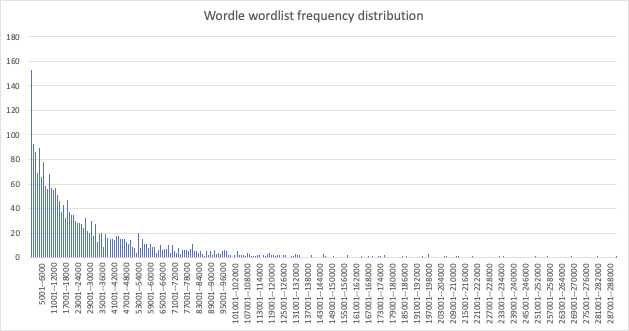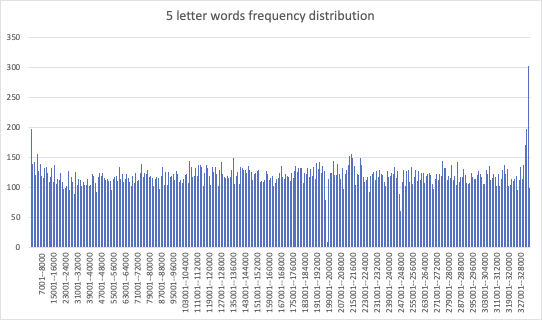Semester starts next week. So what better time to write a blog post (the first in years). To hone my procrastination skills, I spent a couple hours playing around with Wordle this week, delving into its design and implementation. This is what I learned.
The data on which this post is based was obtained by scripting some trivial (and sometimes horribly inefficient) analyses over the Wordle word lists. It’s all publicly available on github.
Overview of Wordle’s Design
Wordle’s design uses two static word lists. The first one is what I’ll call the guesslist, which is an allow-list of words that players are allowed to enter as their guesses. The second list is what I’ll call the wordlist, which is a list of the words that players are trying to guess: each day Wordle chooses the next word from this list and for that day players try to guess that word. For instance, the first word in this list is “cigar”. If you played Wordle on June 19 2021, “cigar” was the word you were trying to guess. The second word in the list is “rebut” and that was the word players were trying to guess on June 20 2021.
What the NYT did, and didn’t, change
Much has been written about Wordle’s move to the New York Times. As widely reported, the NYT removed a handful of words from the wordlist: “agora”, “pupal”, “lynch”, “fibre”, “slave”, and “wench”. It also removed a number of words from the guesslist, chiefly derogatory terms that, in the interests of decency, I won’t list in this post (although they are easily computed). The NYT added no new words to either list.
The NYT’s changes are curious. Many have theorised that words like “agora” and “pupal” were removed because players would be unlikely to guess them. I don’t disagree. However, there are plenty of less commonly used English words that the NYT did not remove. I trust it won’t spoil any players to know that at some point in the future they will find themselves trying to guess “cavil”, “parer”, and “poesy”. For the record, I couldn’t have guessed the meanings of any of these words, and I can’t recall having ever seen any of them before. Players can also look forward to having to guess the doozy “wooer” which, while in the Wordle wordlist, is outside the 333,000 most frequently-used English words—the only such word in the wordlist.
Similarly, while objectionable words like “lynch”, “slave” and “wench” were removed from the wordlist, sexually suggestive words like “kinky” and “horny” remain, and will surely surprise many a player (though you’ll have to wait well over a year before either shows up—as with any other word in the wordlist, the precise date on which each will arise is easily computable). Child players of Wordle will likely struggle to guess “semen”, which also remains on the wordlist along with similar words.
Likewise, while purged of its most offensive entries, the guesslist still contains the English slur “pikey”, as well as a number of sexually explicit slang terms like “skeet” and “felch”, in addition to comparatively mundane (because more common) examples like “porno”, “dildo”. and “boner”. There are surely others too. The entries above were found by comparing against a list of known “dirty, naughty, obscene and otherwise bad words”.
Why Wordle Works
I must admit that when I first started playing Wordle, I had romantic visions of a human “Wordle Editor” employed by the NYT whose job it was each day to choose a new word, more devilish than the last, for players to guess. I was a bit disappointed when I learned that Wordle instead uses its static wordlist, in which the choice about which word players will guess each day was predetermined when Wordle was first created.
However, this design does mean that we can easily interrogate the wordlist, not only to find offensive or obtuse words, but also to understand how Wordle balances ease and difficulty. While my own game development days are long behind me, I know that getting this balance right is crucial for any game’s success.
For Wordle, its gameplay lies not only in its design (a simplification of traditional games like Bulls and Cows) but also in the design of its wordlist. Having a wordlist full of super common words would make it too easy; conversely, a list full of “cavil"s and “poesy"s would make the game too difficult to be rewarding enough to warrant repeat play.
When designing the wordlist, one might choose 5-letter English words at random, for instance. Another choice would be to favour less common words, or, vice-versa, to skew the wordlist towards more common words. You might have your own theories about what kind of wordlist would encourage repeat play and Wordle’s popularity.
Comparing Wordle’s wordlist against a common English word list sorted by frequency reveals that Wordle opted to favour more common words, but with a significant fraction of infrequent English words to ensure sufficient difficulty.

This histogram shows that Wordle’s wordlist contains about 155 words from the first 1000 most common English words (the highest bar). Specifically, each bar represents a bucket of one thousand English words, sorted from left to right by frequency. That is the leftmost buckets are those buckets of words most commonly used.
We can see that Wordle’s wordlist is skewed to favour more commonly used words. However, it has a significant proportion of uncommon words. Apparently, the most frequent 7000 English words account for 90% of what native English speakers use. Interesting, 73% of Wordle’s wordlist comprises words outside of those most frequent 7000. This suggests that while Wordle favours common words, it does so much less than typical English speech and writing. This is precisely where Wordle strikes its balance between ease and difficulty that makes it so fun to play: scouring your mind for those odd, uncommon words that you so rarely get to say in conversation, and the sense of reward that comes when one of those words unlocks a critical stage of the game, is exactly what I love about playing Wordle.
One might imagine that Wordle’s favouring common words is accidental. After all, it might seem intuitive that 5-letter words, being simpler than most other English words, should also expect to be more commonly used. It turns out, however, that 5-letter words are just as common amongst frequently used words as they are amongst infrequently used ones.

If the wordlist was made by selecting 5-letter English words at random, we would expect the shape of the first histogram above to be similar to this one. The difference between the two of them shows the intentional design that was put into the wordlist. It also explains why Wordle would not be nearly as fun if the game selected words for players to guess (uniformly) at random.
Conclusion
So what did we learn? Despite the efforts of the NYT, Wordle still has surprises in store for the prurient; effectively filtering unwanted words remains difficult; for anyone who thinks Wordle is too easy, it has plenty of highly obtuse words in store for players to guess; and, finally, however its wordlist was created, Wordle’s popularity owes much to its careful balance of difficulty and ease of play.